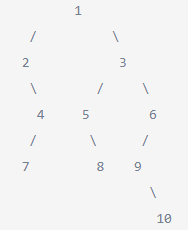【java】代码实现:二叉树的先序遍历、中序遍历、后序遍历、层序遍历
一、节点类
public class Node {
public Node left = null;
public Node right = null;
public int i;
public Node(int i) {
this.i = i;
}
}
二、创建对象
public class NodeUtils {
public static Node newNode(){
Node node = new Node(1);
Node n2 = new Node(2);
Node n3 = new Node(3);
Node n4 = new Node(4);
Node n5 = new Node(5);
Node n6 = new Node(6);
Node n7 = new Node(7);
Node n8 = new Node(8);
Node n9 = new Node(9);
Node n10 = new Node(10);
node.left = n2;
node.right = n3;
n2.right = n4;
n3.left = n5;
n3.right = n6;
n4.left = n7;
n5.right = n8;
n6.left = n9;
n9.right= n10;
return node;
}
}

三、先序遍历(递归)
遍历规则:中左右
结果应该是:1、2、4、7、3、5、8、6、9、10
public class Main {
public static void main(String[] args){
List<Interger> list = new ArrayList<>(); // 存储结果
Node node = NodeUtils.newNode(); // 获取 node 对象
fun(node, list); // 执行
for (Integer i : list)
System.out.println(i); // 输出验证
}
public static void fun(Node node, List<Integer> list){
list.add(node.i);
if(node.left != null) fun(node.left, list);
if(node.right != null) fun(node.right, list);
}
}
四、中序遍历(递归)
遍历规则:左中右
结果应该是:2、7、4、1、5、8、3、9、10、6
public class Main {
public static void main(String[] args){
List<Interger> list = new ArrayList<>(); // 存储结果
Node node = NodeUtils.newNode(); // 获取 node 对象
fun(node, list); // 执行
for (Integer i : list)
System.out.println(i); // 输出验证
}
public static void fun(Node node, List<Integer> list){
if(node.left != null) fun(node.left, list);
list.add(node.i);
if(node.right != null) fun(node.right, list);
}
}
五、后序遍历(递归)
遍历规则:左右中
结果应该是:7、4、2、8、5、10、9、6、3、1
public class Main {
public static void main(String[] args){
List<Interger> list = new ArrayList<>(); // 存储结果
Node node = NodeUtils.newNode(); // 获取 node 对象
fun(node, list); // 执行
for (Integer i : list)
System.out.println(i); // 输出验证
}
public static void fun(Node node, List<Integer> list){
if(node.left != null) fun(node.left, list);
if(node.right != null) fun(node.right, list);
list.add(node.i);
}
}
六、层序遍历(队列)
遍历规则:一层一层
结果应该是:1、2、3、4、5、6、7、8、9、10
java:
public class Main {
public static void main(String[] args) {
Node node = NodeUtils.newNode(); // 获取 node 对象
List<Interger> list = fun(node); // 执行
for (Integer i : list) {
System.out.println(i); // 输出验证
}
}
public static List<Integer> fun(Node node){
List<Integer> list = new ArrayList<>();
if (node != null) {
Queue<Node> queue = new LinkedList<>();
queue.add(node);
do {
Node first = queue.remove();
list.add(first .i);
if(first.left != null) queue.add(first.left);
if(first.right != null) queue.add(first.right);
} while(!queue.isEmpty());
}
return list;
}
}
kotlin:
object Main {
@JvmStatic
fun main(arg: Array<String>) {
val node = NodeUtils.newNode()
process(node).forEach { println(it) }
}
fun process(node: Node?): List<Int> {
node ?: return emptyList()
val list = mutableListOf<Int>()
val queue = LinkedList<>().apply { add(node) }
do {
queue.remove().apply {
list.add(i)
left?.let { queue.add(it) }
right?.let { queue.add(it) }
}
} while(queue.isNotEmpty())
}
}